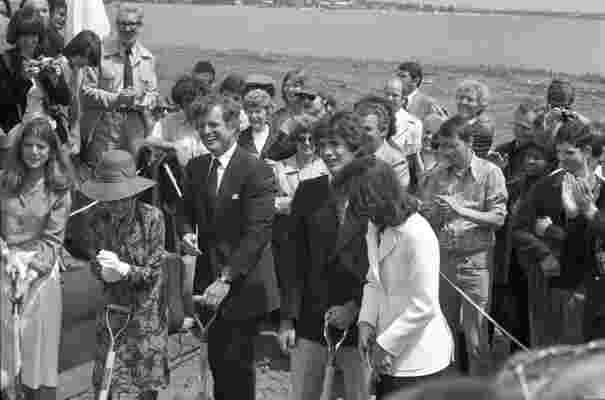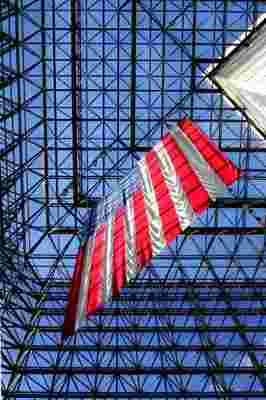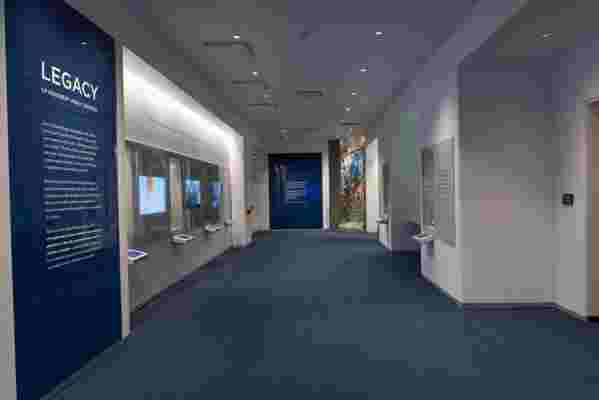On this day 102 years ago, John Fitzgerald Kennedy was born at his family’s home at 83 Beals Street in Brookline, Massachusetts. Today, a mere nine miles southeast of his birthplace, the presidential library and museum that bears his name reaches toward both sky and sea in the form of a triangular nine-story tower that stands dramatically over the tip of Columbia Point, in the Boston neighborhood of Dorchester. Designed by I.M. Pei, who earlier this month passed away at 102 years of age himself, the museum is an architecturally dazzling homage to the legacy of Kennedy’s life, presidency, and promise. As timing would have it, the John F. Kennedy Presidential Library and Museum has just unveiled a newly refurbished exhibition space—its Legacy Gallery, dedicated to JFK’s continuing influence today—and invited AD for an exclusive first look at what went into the new design.
Speaking of legacy, it’s worth noting what a key role Jacqueline Kennedy played in shaping her husband’s from the moment of his death. “It will never be a dead place, merely housing relics and papers of the past,” she said of the future museum. “It will grow and change with the time.” This was something Mrs. Kennedy took to heart. When she met with Pei in 1964, he explained to her that he hadn’t worked on any monumental projects. Though relatively obscure at the time, Pei was nevertheless selected by Mrs. Kennedy from a list of candidates that included several of America’s best-known architects. In Pei, she saw some of the qualities of JFK himself—full of promise, and possessing an imagination and temperament that would create a structure that could reinforce her vision of the library’s goals.

The 1977 groundbreaking ceremony for the John F. Kennedy Presidential Library, with Caroline Kennedy, Rose Kennedy, Edward M. Kennedy, John F. Kennedy Jr., and Jacqueline Kennedy Onassis.
Initially, the library was intended to rise along the banks of the Charles River near Harvard University, and Pei’s design for it included a truncated glass pyramid to symbolize Kennedy’s abruptly terminated life—a design that reemerged 25 years later in Pei’s design for the expansion of the Louvre Museum in Paris. Delays in freeing the site for construction and local concerns about urban congestion meant that the museum needed a new home in Boston. By 1976, this was found in a 9.5-acre site on the Harbor Campus of the University of Massachusetts Boston at Columbia Point, which overlooks the entrance to the Boston Harbor.
Pei started from scratch for the new site. His solution consisted of a triangular nine-story tower that houses archival, educational, and administrative functions; a two-story base containing exhibition space and two 230-seat theaters; and a 115-foot-high glass pavilion, which offers coherence and focus to the whole.
Today, visitors begin their experience at the museum by viewing a short film about Kennedy’s early life before descending into linked exhibition spaces that guide them from the campaign trail through to the election, inauguration, White House years, and the assassination. From the darkened, windowless setting of the museum’s inner spaces, they emerge into the silent void of Pei’s glass-and-steel pavilion, which measures 80 feet long by 80 feet wide and 115 feet high. Except for an enormous U.S. flag suspended above, the space is left empty, to allow for reflection against a great panorama of sky, land, and open sea.

A view of Pei’s glass-and-steel contemplation pavilion.
In describing his design at the time it was completed, Pei observed: “In the silence of that high, light-drenched space, the visitors will be alone with their thoughts. And in the reflective mood that the architecture seeks to engender, they may find themselves thinking of John F. Kennedy in a different way.”
Indeed, to this day Pei’s soaring pavilion fulfills the purpose it was meant to engender. But the link between the “concentrated exhibition area” of which he spoke and his glass-and-steel pièce-de-résistance finale has always been the Legacy Gallery—the one portion of the museum space that bridges a somber, darkened corridor dedicated to the 1963 assassination with the bright, light-flooded pavilion that beckons beyond its doors. Last updated during a 1993 redesign of the museum, the Legacy Gallery seemed in recent years to be aging less consistently with the rest of the museum. The original aesthetic was basically that of a maple-paneled room punctuated by display cases and monitors. Unlike the corridors and exhibitions that come before it, the paneled room began to feel dated. A more contemporary space was needed for today, so the conceptual designer Edwin Schlossberg—Caroline Kennedy’s husband—was called on to oversee its redesign, which was just unveiled in time for Kennedy’s 102nd birthday.

The newly unveiled, modernized and brightened Legacy Gallery.
“The Legacy Gallery was created to document and present the ongoing impact that President Kennedy and his family have had,” Schlossberg tells AD . “The new design has taken this task to a beautiful and really easy-to-understand and easy-to-use experience, showing the continuity of programs such as the Peace Corps, the Space Program, the Profile in Courage Award—using both objects and documents and videos in clear and well-orchestrated presentations.” The team enlisted to execute this vision included designers Amy Forman, of Amy Forman Design, and Roger Westerman, of Roger Westerman Design, along with architect Yugon Kim, of the Boston-based architecture firm ikd, and Paul Montie, of Paul Montie Design. Says Forman, “An important design consideration was that the Legacy Gallery begin the transition from the past to the present—from the 1960s-themed galleries to the present day—as a contemporary, bright, and uplifting place to feel inspired.”
According to Forman, the light that filters into the gallery from the glass pavilion influenced the design team’s choices toward “reflective materials that sparkle.” The defining themes of JFK’s legacy were also a driving force behind the overall plan: innovation, inclusion, promoting the arts, public service, and global citizenship. “Knowing that we had the opportunity to gut the gallery with an architect,” Westerman says, “gave us the ability to start arranging the media and the artifacts in a way that communicated these concepts and ideas and that hadn’t been done before.”
The Legacy Gallery's newly installed rotunda of gently moving images.
In its new articulation, the Legacy Gallery is a gleaming, ceremonial segue to the present day, offering a transition from the 1960s to Pei’s timeless pavilion. As visitors come out of the dark corridor that documents the assassination, they find themselves in a small rotunda of changing images of places from around the world that are named for President Kennedy. Forman explains how they’ve kept the static images but have enhanced the rotunda with a new series of gently moving images, so that visitors understand just how many places are named in Kennedy’s honor.
“The new gallery has also been designed so that is can be easily updated, since so many of the ideas and themes of the Kennedy Presidency continue to be relevant and interesting to all generations of visitors,” Schlossberg comments. For a museum made of white precast concrete, the design of this new Legacy Gallery is rooted in something not so concrete, but rather an idea. “The gallery is not about reverence for President Kennedy the person,” Westerman concludes. “It is about celebrating his vision and his ideas—because those are eternal.”
